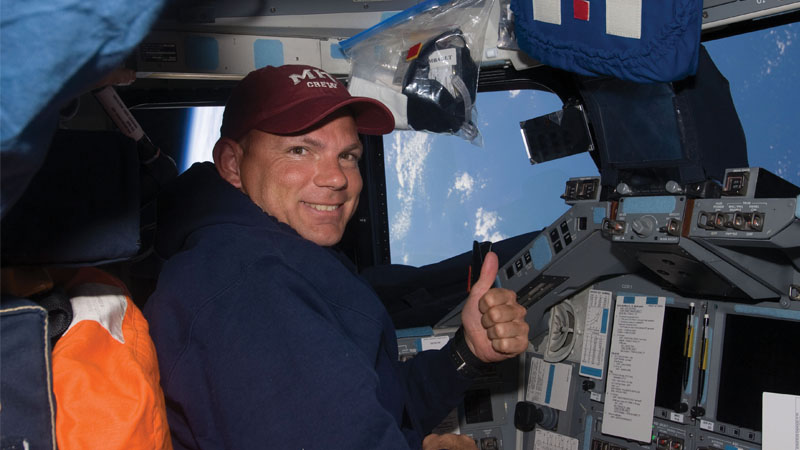Stay Up to Date
Submit your email address to receive the latest industry and Aerospace America news.
Tony Antonelli, Lockheed Martin’s chief technologist for exploration
When former astronaut Tony Antonelli looks out the window of his Houston office, he doesn’t see any mountains. His colleagues at Lockheed Martin’s Waterton Canyon Campus in Colorado can’t miss them. In May, Antonelli’s team unveiled a mountaineering-inspired proposal to pre-position key pieces of an outpost in orbit around Mars, and launch the remaining elements and a crew of six to it in 2028. Once aboard, the crew would robotically explore Mars with rovers and maybe with unmanned aircraft before a crew would be dispatched to the surface.
The company’s Mars Base Camp proposal amounts to a gentle nudge to NASA and Congress to set a firm target date for reaching Mars with a human crew. Antonelli led the team of architects and engineers that drew up the plan. The team looked at the date question and determined that a crew could be launched toward Mars in 2028, whereas NASA says only that it aims to send humans to Mars “in the 2030s.” Also, technical literature is often filled with calls for exotic propulsion technologies, radiation protection breakthroughs and in situ resource utilization. Antonelli says existing technology could be developed into the components necessary to put a crew into orbit around Mars.
In His Own Words
Social impact of spaceflight
I looked down at Earth and thought, “Everybody I know lives there.” I didn’t fully appreciate that all of us together live on this one spaceship Earth. I’m actually surprised we don’t treat each other more neighborly when we think about how close we all live together relative to the bigger picture. Somehow, [those of us who have flown are] leaving something out of telling the story, because people aren’t able to wrap their minds around it. Certainly, if this crew of six in Mars orbit is able to discover life somewhere else, that I think really will be changing for us.
Setting a specific date for reaching Mars
My boss [Wanda Sigur, vice president and general manager of civil space] said, “This idea of human exploration of Mars has excited me my whole life. The idea of reaching Mars [decades from now] is too far for me to get my hands on. It doesn’t feel very real, it feels too far in the future.” So, she tasked me with putting together a plan that makes human exploration of Mars real and tangible. The idea was, “With the technology that we have today, with the country’s investment in SLS [Space Launch System] and Orion what else do we need to get human exploration on Mars well underway, kind of make it achievable in our careers as opposed to, you know, dreams of our grandchildren?” We can make this happen in the 2028 time frame, which feels real.
Value of a deadline
When you say, “the 2030s,” it kind of brings this idea of a range. We’re trying to focus in on what we can accomplish specifically and as quickly as we can and safely. If you don’t put a date on it, then for example, “What’s the very best in-space propulsion to use?” You’ll never be forced to pick and move out on a plan, if there’s no sense of urgency in going.
Working with what you know today
The future will consist of the in situ resource utilization: The water, the rocks and the dirt [on Mars]. But you don’t have to wait for all that technology to be fully developed to get started … We’ve got [SLS] well on its way, and Orion well on its way, the EM-1 [Exploration Mission-1] vehicle got welded together, it got proof tested. It just recently got moved into the clean room so they can add the propulsion system to that spacecraft that’s going to go out past the moon in 2018.
Controlling drones and rovers from orbit
I’m convinced that one of our rovers has driven past something that was scientifically significant but we weren’t there in real time controlling it [from orbit] and collecting all the data. You could fly UAVs, you could fly helicopters. You could serve an important role in the Mars sample return, [which] has been at the very top of the decadal survey for a few rounds now. There [are] significant planetary protection rules with forward contamination and backwards contamination. With the scientists in a laboratory in orbit around Mars and robotically launching samples off of the surface of Mars, you could help break the chain that would then satisfy the planetary protection requirements for Mars sample return. ★
About Ben Iannotta
As editor-in-chief from 2013 to March 2025, Ben kept the magazine and its news coverage on the cutting edge of journalism. He began working for the magazine in the 1990s as a freelance contributor. He was editor of C4ISR Journal and has written for Air & Space Smithsonian, New Scientist, Popular Mechanics, Reuters and Space News.
Related Posts
Stay Up to Date
Submit your email address to receive the latest industry and Aerospace America news.




